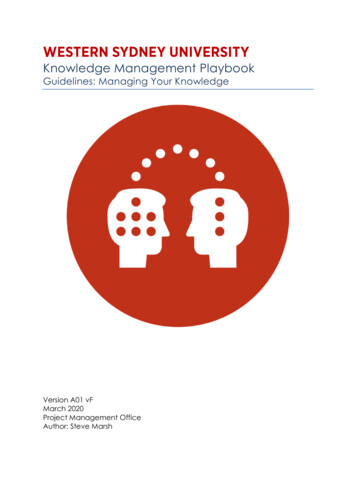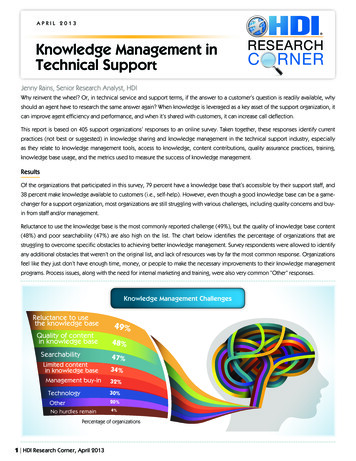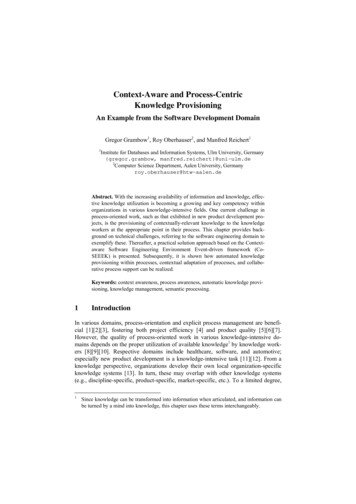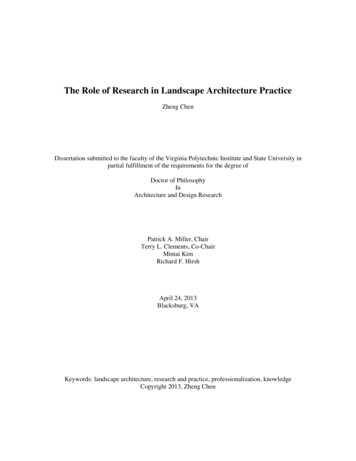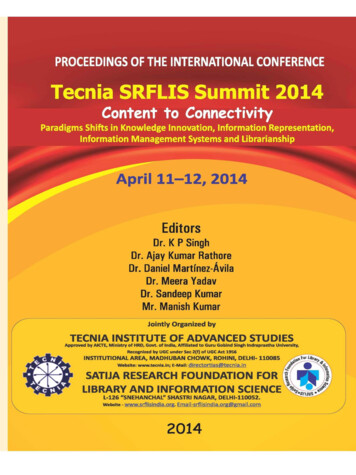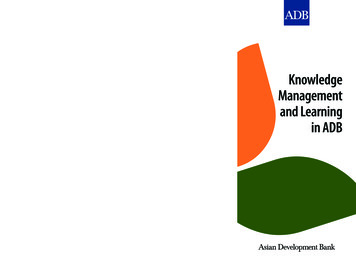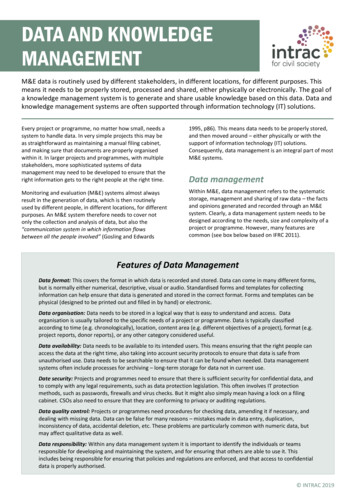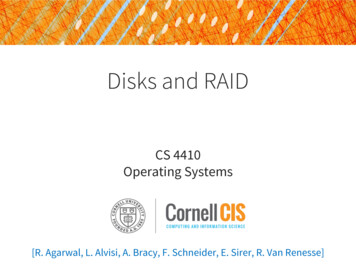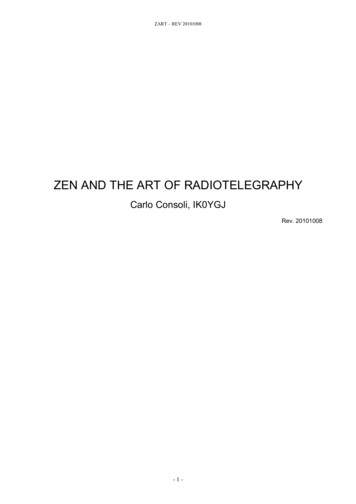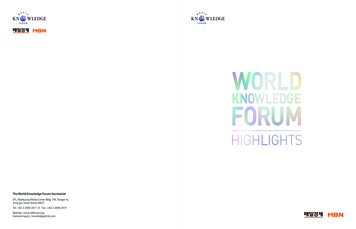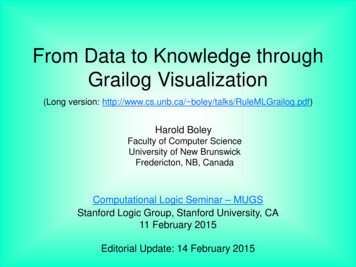
Transcription
From Data to Knowledge throughGrailog Visualization(Long version: http://www.cs.unb.ca/ boley/talks/RuleMLGrailog.pdf)Harold BoleyFaculty of Computer ScienceUniversity of New BrunswickFredericton, NB, CanadaComputational Logic Seminar – MUGSStanford Logic Group, Stanford University, CA11 February 2015Editorial Update: 14 February 2015
1AcknowledgementsThanks for feedback on various versions and parts of this presentation(the long version has all parts, hence gapless slide numbers):From Data to Knowledge through Grailog VisualizationDecision CAMP, eBay Town Hall, San Jose, CA , 4-6 November 2013Ontology, Rules, and Logic Programming for Reasoning and Applications (RulesReasoningLP) Ontolog Mini-Series, 31 October 2013ISO 15926 and Semantic Technologies 2013 Conference, Sogndal, Norway, 5-6 September 2013Grailog 1.0: Graph-Logic Visualization of Ontologies and RulesThe 7th International Web Rule Symposium (RuleML 2013), University of Washington, Seattle, WA, 11-13 July 2013The Grailog Systematics for Visual-Logic Knowledge Representation with Generalized GraphsFaculty of Computer Science Seminar Series, University of New Brunswick, Fredericton, Canada, 26 September 2012High Performance Computing Center Stuttgart (HLRS), Stuttgart, Germany, 14 August 2012Grailog: Mapping Generalized Graphs to Computational LogicSymposium on Natural/Unconventional Computing and its Philosophical Significance,AISB/IACAP World Congress - Alan Turing 2012, 2-6 July 2012, Birmingham, UKThe Grailog User Interface for Knowledge Bases of Ontologies & RulesOMG Technical Meeting, Ontology PSIG, Cambridge, MA, 21 June 2012Grailog: Knowledge Representation with Extended Graphs for Extended LogicsSAP Enterprise Semantics Forum, 24 April 2012Grailog: Towards a Knowledge Visualization StandardBMIR Research Colloquium, Stanford, CA, 4 April 2012PARC Research Talk, Palo Alto, CA, 29 March 2012RuleML/Grailog: The Rule Metalogic Visualized with Generalized GraphsPhiloWeb 2011, Thessaloniki, Greece, 5 October 2011Grailog: Graph inscribed logicCourse about Logical Foundations of Cognitive Science, TU Vienna, Austria, 20 October -10 December 2008
2AbstractDirected labeled graphs (DLGs) provide a good starting point for visual data &knowledge representation but cannot straightforwardly represent nested structures,non-binary relationships, and relation descriptions. These advanced featuresrequire encoded constructs with auxiliary nodes and relationships, which also needto be kept separate from straightforward constructs. Therefore, various extensionsof DLGs have been proposed for data & knowledge representation, including graphpartitionings (possibly interfaced as complex nodes), n-ary relationships as directedlabeled hyperarcs, and (hyper)arc labels used as nodes of other (hyper)arcs.Meanwhile, a lot of AI / Semantic Web research and development on ontologies &rules has gone into extended logics for knowledge representation such as object(frame) logics, description logics, general modal logics, and higher-order logics.The slides demonstrate how data & knowledge representation with graphs andlogics can be reconciled. They proceed from simple to extended graphs for logicsneeded in AI and the Semantic Web. Along with its visual introduction, each graphconstruct is mapped to its corresponding symbolic logic construct. These graphlogic extensions constitute a systematics defined by orthogonal axes, which has ledto the Grailog 1.0 language as part of the Web-rule industry standard RuleML 1.0(http://wiki.ruleml.org/index.php/Grailog). While Grailog's DLG sublanguagecorresponds to binary-associative memories, its hypergraph sublanguagecorresponds to n-ary content-addressable memories, and its complex-nodemodules offer various further opportunities for parallel processing
3Visualization of Data Useful in many areas, needed for big data Gain knowledge insights from data analytics,ideally with the entire pipeline visualized Statistical visualization Logical visualizationSample datavisualization(http://wordle.net):Word cloudfor frequencyof words fromBMIR abstractof this talk
4Visualization of Data & Knowledge:Graphs Make Logic Low-Entry-Cost From 1-dimensional symbol-logic knowledgespecification to 2-dimensional graph-logicvisualization in a systematic 2D syntax– Supports human in/on the loop of knowledgeelicitation, specification, validation, and reasoning Combinable with graph transformation,(‘associative’) indexing & parallel processingfor efficient implementation of specifications Move towards model-theoretic semantics– Unique names, as graph nodes, mapped directly/injectively to elements of semantic interpretation
5Rule MetaLogic ProvidesFamily of Language Standards forWeb Data & Knowledge Interchange Developed on the Web:http://ruleml.org/metalogic Principal (family-uniform) andvariant semantics Family-uniform syntaxes forhumans and machines
6Three RuleML Syntaxes ationRuleML/Grailog RuleML/POSL RuleML/XML
7Three RuleML Syntaxes (2)Serialization RuleML/XML:Specified in XML Schema and recently in Relax NG:http://ruleml.orgPresentation RuleML/POSL:Integrates Prolog and F-logic, and translates to hp/jetwi/article/view/0204343353Visualization RuleML/Grailog:Based on Directed Recursive Labelnode Hypergraphs (DRLHs):http://www.dfki.uni-kl.de/ boley/drlhops.abs.html
8GrailogGraph inscribed logic provides intuition for logicAdvanced cognitively motivated systematicgraph standard for visual-logic data & knowledge:Features orthogonal easy to learn,e.g. for (Business) AnalyticsGeneralized-graph framework as one uniform2D syntax for major (Semantic Web) logics:Pick subset for each targeted knowledge base,map to/fro RuleML sublanguage, and exchange& validate it, posing queries again in Grailog
Grailog’s Integrated Representationsand API4KB9 Grailog covers the main data & knowledgerepresentation paradigms, needed in API4KB:– Integrated Directed Labeled Graph (e.g. RDF)and Relational (Datalog-fact-like) data– Integrated Ontology (e.g. RDFS and descriptionlogic) and Rule (Horn & general-logic) knowledge Besides mapping Grailog to/fro RuleML,RDF and UML OCL can be targeted, withuniform access to be provided by API4KB An API can be (initially) designed and testedwith a human in the loop much like a GUI
Represent and Map Logic LanguagesAccording to Grailog 1.0 Systematics10 We have used generalized graphs for representingvarious logic languages, where basically:– Graph nodes (vertices) represent individuals, classes, etc.– Graph arcs (edges) represent relationships Next slides:What are the principles of this representation andwhat graph generalizations are required? Central slides:How are these graphs mapped (invertibly) to logic,thus specifying Grailog as a ‘GUI’ for knowledge? Later slides:What is the systematics of Grailog features? Final slides:How is RuleML transformed to Grailog in SVG?
Grailog Principles11 Graphs should make it easier for humans to readand write logic constructs via a 2D state-of-the-artrepresentation with shorthand & normal forms,from Controlled English to logic Graphs should be natural extensions (e.g. n-ary)of Directed Labeled Graphs (DLGs), often usedto represent simple semantic nets, i.e. of atomicground formulas in function-free dyadic predicatelogic (cf. binary Datalog ground facts, RDF triples,the Open Graph, and the Knowledge Graph) Graphs should be compositional, e.g. allowingrefinements for logic constructs: Description Logicconstructors, F-logic frames, PSOA RuleML terms, . Extensions to boxes & links should be orthogonal
Informal Grailog Preview:Searle’s Chinese Room ArgumentJohn Searle (emphasis added): “. whatever purely formalprinciples you put into thecomputer, they will not besufficient for understanding,since a human will be able tofollow the formal principleswithout understanding anything.”(Minds, Brains and Programs, 1980)12
Searle’s Chinese Room Scenario:Grailog for Visual Controlled EnglishClasses with nWangInstances with relationshipslang distinguishable
14Grailog Generalizations Directed hypergraphs: For n-ary relationships,directed relation-labeled (binary) arcs will be generalizedto directed relation-labeled (n-ary) hyperarcs, e.g.representing relational-database tuples Recursive (hierarchical) graphs: For nested termsand formulas, modal logics, and modularization, ‘flat’graphs will be generalized to allow other graphs ascomplex nodes to any level of ‘depth’ Labelnode graphs: For allowing higher-order logicsdescribing both instances and relations (predicates),arc labels will also become usable as nodes
15Graphical Elements: Names Written into boxes (nodes):Unique (canonical, distinct) namesunique– Unique Name Assumption (UNA)refined to Unique Name Specification (UNS) Written onto boxes (node labels):Non-unique (alternate, ‘aka’) namesnon-unique– Non-unique Name Assumption (NNA)refined to Non-unique Name Specification (NNS) Grailog combines UNS and NNS: xNS, with x U or N
16Different Unique Names Different ReferentsNames:Referents:VenusMarsvm
17Equated Different Unique Names No ReferentsNames:Referents:VenusMars
18Different Non-Unique Names Different ReferentsMorningstarEveningstarvwNames:Referents:
19Equated Different Non-Unique Names(“Synonym”) Same Names:Referents:Morningstar Eveningstarvv
Equated Different Non-Unique Names(“Synonym”) and Same Unique Name Same sVenusv20Morningstar Eveningstar𝑚𝑒𝑟𝑔𝑒Venusv
Same Non-Unique NameDifferent Unique Names (“Homonym”) No rents:Unique Referent Principle (URP)21
22Instances: Individual Constantswith Unique Name SpecificationsmappingGeneral:Graph (node)LogicuniqueuniqueExamples: GraphLogicWarren BuffettWarren BuffettGeneral ElectricGeneral ElectricUS 3·109US 3·109
23Instances: Individual Constantswith Non-unique Name SpecificationsGeneral:Graph (node)non-uniquemappingLogic (vertical barfor non-uniqueness) non-uniqueExamples: GraphLogicWB WBGE GEUS 3B US 3B
24Graphical Elements: Hatching Patterns No hatching (boxes): Constant Hatching (elementary boxes): Variable
25Parameters: Individual VariablesGeneral:Graph (hatched node) Logic (italics font,POSL uses “?” prefix)variableExamples: GraphvariableLogicXXYYAA
26Predicates: Binary Relations (1)General:Graph (labeled arc)inst1binrelinst2Example: GraphWarren BuffettTrustLogicbinrel(inst1, inst2)LogicGeneral ElectricTrust(Warren Buffett,General Electric)
27Predicates: Binary Relations (2)General:Graph (labeled arc)var1binrelExample: GraphXTrustvar2Logicbinrel(var1, var2)LogicYTrust(X,Y)
28Ground Equality:Identifying Pairs of ConstantsGeneral:Graph (unlabeledundirected arc)Logic (with equality)inst1inst1 inst2inst2Example: GraphLogicGEGeneral Electric GE General ElectricInspired by Charles Sanders Peirce’s line of identity, as a co-reference link
29Ground Equality:Defining Constants with ConstantsGeneral:Graph (unlabeledundirected,colon-tailed arc)Logic (with orientedequality)inst1inst1 : inst2:inst2Example: GraphLogicGE:General Electric GE : General Electric
30Ground Equality:Defining Symbolic Constants as IRIsGeneral:Graph (unlabeledundirected,colon-tailed arc)Logic (with orientedequality, webized)instinst : IRI:IRIExample: GraphLogicGenElec:http://www.ge.com/ GenElec : http://www.ge.com/Definitional equality can also be used for the prefix part of the CURIE notation
31Negated Predicates: Binary Relations(Shorthand)General:Graph (dashed arc)inst1binrelinst2Example: GraphJoe SmallstockTrustLogic binrel(inst1, inst2)LogicGeneral Electric Trust(Joe Smallstock,General Electric)
32Negated Predicates: Binary Relations(Long Form)General:Graph (dashed box)inst1binrelinst2Example: GraphJoe SmallstockTrustLogic (binrel(inst1, inst2))LogicGeneral Electric (Trust(Joe Smallstock,General Electric))
33Ground Inequality: Pairwise Difference(Shorthand)General:Graph (dashedunlabeledundirected arc)Logic (with equality)inst1inst1 inst2inst2Example: GraphJoe SmallstockLogic (with equality)Warren BuffettJoe Smallstock Warren Buffett
34Ground Inequality: Pairwise Difference(Long Form)General:Graph (dashed box,unlabeledundirected arc)Logic (with equality)inst1 (inst1 inst2)inst2Example: GraphJoe SmallstockLogic (with equality)Warren Buffett (Joe Smallstock Warren Buffett)
35Graphical Elements: Arrows (1) Labeled arrows (directed links) for arcs andhyperarcs (where hyperarcs ‘cut through’ nodesintermediate between first and last)
36Predicates: n-ary Relations (n 1)General:Graph (hyperarc)Logicrelinst1inst2instn-1Example: Graph(n 3)WBInvestinstnrel(inst1, inst2, .,instn-1, instn)LogicGEUS 3·109Invest( WB, GE,US 3·109)
37Negated Predicates: n-ary Relations(Shorthand)General:Graph (dashed hyperarc) Logicrelinst1inst2instn-1Example: Graph(n 3)WBInvestinstn rel(inst1, inst2, .,instn-1, instn)LogicGEUS 4·109 Invest( WB, GE,US 4·109)
38Negated Predicates: n-ary Relations(Long Form)General:Graph (dashed box)relinst1inst2instn-1Example: Graph(n 3)WBInvestinstnLogic (rel(inst1,inst2, .,instn-1, instn))LogicGEUS 4·109 (Invest( WB, GE,US 4·109))
39Implicit Conjunction of Formula Graphs:Co-Occurrence on Graph Top-LevelGeneral:Graph (m hyperarcs)inst1,1 rel1 inst1,2inst1,n1instm,1 relm instm,2instm,nm.Example: Graph (2 hyperarcs)WBGEUS InvestJS3·109VWInvestUS 2·104Logicrel1(inst1,1, inst1,2,., inst1,n1) relm(instm,1, instm,2,.,instm,nm).LogicInvest( WB, GE,US 3·109) Invest( JS, VW,US 2·104)
40Explicit Conjunction of Formula Graphs:Co-Occurrence in (parallel-processing) And NodeGeneral:Graph (solid linear)inst1,1 rel1 inst1,2inst1,n1instm,1 relm instm,2instm,nm.Example: GraphWBJSUS 3·109VWInvest(rel1(inst1,1, inst1,2,., inst1,n1) relm(instm,1, instm,2,.,instm,nm)).LogicGEInvestLogicUS 2·104(Invest( WB, GE,US 3·109) Invest( JS, VW,US 2·104))
Not of And of Formula Graphs:Co-Occurrence in a Not’s And NodeGeneral:41Graph (dashed/solid linear) Logicinst1,1 rel1 inst1,2inst1,n1instm,1 relm instm,2instm,nm.Example: GraphWBJSUS 3·109VWInvest.LogicGEInvest (rel1(inst1,1, inst1,2,., inst1,n1) relm(instm,1, instm,2,.,instm,nm))US 2·104 (Invest( WB, GE,US 3·109) Invest( JS, VW,US 2·104))
42Not of And (Nand) of Formula Graphs:Co-Occurrence in Nand Node (Shorthand)General:Graph (dashed linear) Logicinst1,1 rel1 inst1,2inst1,n1instm,1 relm instm,2instm,nm.Example: GraphWBJSUS 3·109VWInvest.LogicGEInvest (rel1(inst1,1, inst1,2,., inst1,n1) relm(instm,1, instm,2,.,instm,nm))US 2·104 (Invest( WB, GE,US 3·109) Invest( JS, VW,US 2·104))
Disjunction of Formula Graphs:Co-Occurrence in Or NodeGeneral:Graph (solid wavy)inst1,1 rel1 inst1,2inst1,n1instm,1 relm instm,2instm,nm.Example: GraphWBJSUS 3·109VWInvestLogic(rel1(inst1,1, inst1,2,., inst1,n1) relm(instm,1, instm,2,.,instm,nm) ).LogicGEInvest43US 2·104(Invest( WB, GE,US 3·109) Invest( JS, VW,US 2·104))
Not of Or of Formula Graphs:Co-Occurrence in a Not’s Or NodeGeneral:44Graph (dashed/solid linear/wavy) Logicinst1,1 rel1 inst1,2inst1,n1instm,1 relm instm,2instm,nm.Example: GraphWBJSUS 3·109VWInvest.LogicGEInvest (rel1(inst1,1, inst1,2,., inst1,n1) relm(instm,1, instm,2,.,instm,nm) )US 2·104 (Invest( WB, GE,US 3·109) Invest( JS, VW,US 2·104))
45Not of Or (Nor) of Formula Graphs:Co-Occurrence in Nor Node (Orthogonal Shorthand)General:Graph (dashed wavy) Logicinst1,1 rel1 inst1,2inst1,n1instm,1 relm instm,2instm,nm.Example: GraphWBJSUS 3·109VWInvest.LogicGEInvest (rel1(inst1,1, inst1,2,., inst1,n1) relm(instm,1, instm,2,.,instm,nm) )US 2·104 (Invest( WB, GE,US 3·109) Invest( JS, VW,US 2·104))
46From Hyperarc Crossings to Node Copiesas a Normalization Sequence (1)Hypergraph (2 hyperarcs,crossinginside a node)JohnShowMary TeachLatinDLG (4 arcs, do not specifyto whom Latinis shown or taught)ShowPaulJohnKateMary TeachSymbolic Controlled English“John shows Latin to Kate.Mary teaches Latin to Paul.”LatintotoPaulKate
47From Hyperarc Crossings to Node Copiesas a Normalization Sequence (1*)Hypergraph (2 hyperarcs,DLG (4 arcs, do not specifycrossingto whom Latinoutside nodes)is shown or taught)JohnShowMary TeachLatinShowPaulJohnKateMary TeachLatintotoPaulKate
48From Hyperarc Crossings to Node Copiesas a Normalization Sequence (1**)Hypergraph (2 hyperarcs,DLG (4 arcs, do not specifyparallel-cuttingto whom Latina node)is shown or taught)John ShowKateJohnShowKateLatinLatinMary TeachtoPaulMary TeachtoPaulThe hyperarc for, e.g., ternary Show(John,Latin,Kate) can be seen as the pathcomposing the 2 arcs for binary Show(John,Latin) and binary to(Latin,Kate)
49From Hyperarc Crossings to Node Copies Insert on Correct Binary ReductionHypergraph (2 hyperarcs,DLG (8 arcs with 4 ‘reified’parallel-cuttingrelation/ship nodes toa node)point to arguments)ShowShow1arg1John ShowKatearg3KateJohnLatinLatinMary Teacharg2PaulPaulMaryarg1arg2Teach1Teacharg3
50From Hyperarc Crossings to Node Copiesas a Normalization Sequence (1***)Hypergraph (2 hyperarcs,employinga node copy)John Show LatinKateMary Teach LatinPaulLogic (2 relations,employinga symbol copy)Show(John, Latin, Kate) Teach(Mary, Latin, Paul)Both ‘Latin’ occurrences remain one node even when copied for easier layout:Having a unique name, ‘Latin’ copies can be merged again.This “fully node copied” normal form can help to learn the symbolic form, isimplemented by Grailog KS Viz, and demoed in the Loan Processor test suite
From Predicate Labels on Hyperarcsto Labelnodes Starting HyperarcsGeneral:51Graph (hyperarc withLogicrect4vex-shaped rel(inst1, inst2, .,labelnode)instn-1, inst2instn-1instn(Normal Form)Example: Graph(n 3)WBInvestWBInvestGEGELogicInvest( WB, GE,US 3·109US 3·109)US 3·109
52From Predicate Labels on Arcsto Labelnodes Starting Binary HyperarcsGeneral:Graph (arc)Logicbinrelbinrelinst1inst2inst1inst2Example: GraphLogicTrustTrustbinrel(inst1, inst2)Trust(Warren Buffett,General Electric)Warren BuffettGeneral ElectricWarren BuffettGeneral Electric
53Arities Smaller than in Binary DLGs:Labelnodes Starting Unary Hyperarcs(cf. Slide on Classes, Concepts, Types)General:GraphunaryrelLogicinst1Example: GraphFrugalWarren Buffettunaryrel(inst1)LogicFrugal(Warren Buffett)
54Labelnodes Starting Hyperarcs EnableSecond-Order Predicates (e.g. Binary):Hyperarcs with Labelnode ArgumentsGeneral:Graph (2-adorned rect4vex: 2nd order)binrel2ndord2rel1rel2Example: alProdigalAntonym(Frugal,Prodigal)
Arities Smaller than in Binary DLGs:Labelnodes for Nullary Hyperarcs(cf. Propositional Logic)General:GraphnullaryrelExample: GraphSunnyLogicnullaryrel()LogicSunny()55
Functions ‘Actively’ Applied toArguments (Shorthand)General:Graph (hyperarc stn-1Example: Graph(n 3)WBProfit56fun(inst1, inst2, .,instn-1, instn)instnLogicYY2011Profit( WB, YY,2011)
Function Apps Value-Returning:‘Active’ Call (Long Form)General:funGraph (round2cave-shaped Logicenclosing box)fun(inst1, inst2, .,instn-1, instn)inst1inst2instn-1Example: Graph(n 3)WBProfit57instnLogicYY2011Profit( WB, YY,2011)
Function Apps Value-Returning:Result for Definition of Next SlideGeneral:GraphLogicvalvalExample: Graph(n 3)LogicUS 2·106US 2·10658
Function Apps Value-Returning:Logic with Equality Definition (1)General:funGraph (ground)inst1inst2Logicfun(inst1, inst2, .,instn-1, instn): valvalinstn-1instn:Example: Graph(n 3)WBProfit59LogicYY2011:Profit( WB, YY,2011)US 2·106: US 2·106
Function Apps Value-Returning:Logic with Equality Definition (2)General:Graph (inst/var terms)60Logic( vari)fun(term1, term2, .,termn) : valfunterm1term2termnExample: Graph(n 1)DoubleX:valLogic( X):MultX2Double(X) : Mult(X, 2)
61Double Function Sample Call:Rewriting Trace (1)GraphDoubleLogic3Double(3)Call/query of Double instantiates equality definition of previous slide (X 3)
62Double Function Sample Call:Rewriting Trace (1’)GraphMult3Logic2Mult(3, 2)Call/query of Mult assumed to be computed by a built-in definition (3*2)
63Double Function Sample Call:Rewriting Trace (1’’)Graph6Logic6More in slides about Functional-Logic Programming with (oriented) equations,which can be visualized and animated as above, for students from Code Kidsto graduate-level CS courses (cf. eLearning in “Conclusions”)
Function Apps Value-Denoting:‘Passive’ Data ConstructionGeneral:funGraph (rect2cave-shapedenclosing box)inst1inst2instn-1Example: Graph(n 3)WBProfitLogic (POSL)fun[inst1, inst2, .,instn-1, instn]instnLogicYY201164Profit[ WB, YY,2011]
Predicates: Unary Relations(Classes, Concepts, Types)General:Graph (class appliedto instance le: GraphBillionaireWarren BuffettLogicBillionaire(Warren Buffett)
66Negated Predicates: Unary RelationsGeneral:Graph (class dash-appliedto instance node)classnot HasInstanceLogic class(inst1)inst1Example: GraphBillionaireLogic Billionaire(Joe Smallstock)Joe Smallstock
67Graphical Elements: Arrows (2) Arrows for special arcs and hyperarcs– HasInstance: Connects class, as labelnode,with instance (hyperarc of length 1) As in DRLHs and shown earlier, labelnodes can alsobe used (instead of labels) for hyperarcs of length 1– SubClassOf: Connects subclass, unlabeled,with superclass (arc, i.e. of length 2)– Implies: Hyperarc from premise(s) to conclusion– Object-IDentified slots and shelves: Bulletedarcs and hyperarcs
68Class Hierarchies (Taxonomies):Subclass RelationGeneral:Graph (two s2class1Example: ich
69Class Hierarchies (Taxonomies):Negated Subclass RelationGeneral:Graph (two nodes)class2not ple: oor
70Intensional-Class Constructions (Ontologies):Class IntersectionGeneral:class1Graph (solid linear node,as for lass2.classnExample: nmentalistBillionaireBenefactorEnvironmentalist
71Intensional-Class Applications:Class IntersectionGeneral:class1Graph (complex classapplied to instance ss2.classn)(inst1)inst1Example: mentalistWarren )(Warren Buffett)
72Intensional-Class Constructions (Ontologies):Class UnionGeneral:class1Graph (solid wavy node,as for lass2.classnExample: nmentalistBillionaireBenefactorEnvironmentalist
73Intensional-Class Applications:Class UnionGeneral:class1Graph (complex classapplied to instance ss2.classn)(inst1)inst1Example: mentalistWarren )(Warren Buffett)
74Intensional Class Constructions (Ontologies):Class ComplementGeneral:Graph(Description)(dashed linear node,Logicas for negation containsnode to be complemented)Arbitrary classclassAtomic class(shorthand)classExample: GraphBillionaire class(Description)BillionaireLogic Billionaire
75Class Hierarchies (Taxonomy DAGs):Top and BottomGeneral:Top (special node)(Description)Logic (owl:Thing)General:Bottom (special node)(Description)Logic (owl:Nothing)
76Intensional Class Constructions (Ontologies):Class-Property Restriction Existential (1)General: Graph (shorthand) binrelclassExample: Graph (Description)Logic binrel . class(Description)Logic SubstancePhysical Substance . PhysicalA kind of schema, where Top class is specialized to have (multi-valued)attribute/property, Substance, with at least one value typed by class Physical
77Intensional Class Constructions (Ontologies):Class-Property Restriction Existential (1*)General: Graph (normal) binrelclassExample: Graph (Description)Logic binrel . class(Description)Logic SubstancePhysical Substance . PhysicalA kind of schema, where Top class is specialized to have (multi-valued)attribute/property, Substance, with at least one value typed by class Physical
78Instance Assertions (Populated Ontologies):Using Restriction for ABox Existential (1)General:Graph (shorthand) (xNS-Description)Logic binrel classbinrelinst0inst1Example: Graph SubstanceSocratesPhysicalSubstanceP1 binrel.class(inst0) class(inst1) binrel(inst0, inst1)(xNS-Description)Logic Substance.Physical(Socrates) Physical(P1) Substance(Socrates, P1)
79Instance Assertions (Populated Ontologies):Using Restriction for ABox Existential (1*)General:Graph (normal) binrel classbinrelinst0inst1Example: Graph on)Logic binrel.class(inst0) class(inst1) binrel(inst0, inst1)(xNS-Description)Logic Substance.Physical(Socrates) Physical(P1) Substance(Socrates, P1)
80Intensional Class Constructions (Ontologies):Class-Property Restriction Universal (1)General: Graph (shorthand) binrelclassExample: Graph (Description)Logic binrel . class(Description)Logic SubstancePhysical Substance . PhysicalA kind of schema, where Top class is specialized to have (multi-valued)attribute/property, Substance, with each value typed by class Physical
81Intensional Class Constructions (Ontologies):Class-Property Restriction Universal (1*)General: Graph (normal) binrelclassExample: Graph (Description)Logic binrel . class(Description)Logic SubstancePhysical Substance . PhysicalA kind of schema, where Top class is specialized to have (multi-valued)attribute/property, Substance, with each value typed by class Physical
82Instance Assertions (Populated Ontologies):Using Restriction for ABox Universal (1)General:Graph (shorthand) binrel classinst0binrel inst1.binrel.instnExample: Graph PhysicalSocratesSubstance binrel.class(inst0) class(inst1) .class(instn) binrel(inst0, inst1) .binrel(inst0, instn)(xNS-Description)Logic SubstanceSubstance(xNS-Description)LogicP1P2 Substance.Physical(Socrates) Physical(P1) Physical(P2) Substance(Socrates, P1) Substance(Socrates, P2)
83Instance Assertions (Populated Ontologies):Using Restriction for ABox Universal (1*)General:Graph (normal) binrel classinst0binrel inst1.binrel.instnExample: Graph PhysicalSocratesSubstance binrel.class(inst0) class(inst1) .class(instn) binrel(inst0, inst1) .binrel(inst0, instn)(xNS-Description)Logic SubstanceSubstance(xNS-Description)LogicP1P2 Substance.Physical(Socrates) Physical(P1) Physical(P2) Substance(Socrates, P1) Substance(Socrates, P2)
Existential vs. Universal Restriction84(Physical/Mental Assumed Disjoint: Can Be Explicated via Bottom Intersection)ConsistentInconsistentExample: GraphMental Substance PhysicalSubstanceSocratesP1P3SubstanceMental Substance PhysicalSocratesSubstance Substance.Physical(Socrates) Physical(P1) Mental(P3) Substance(Socrates, P1) Substance(Socrates, P3)Example: iption)Logic Substance.Physical(Socrates) Physical(P1) Mental(P3) Substance(Socrates, P1) Substance(Socrates, P3)
85LuckyParent Example (1)LuckyParentLuckyParent Person Spouse.Person Child.( Poor Child.Doctor)EquivalentClasses Person ChildPoor ChildDoctor Spouse
LuckyParent Example (1*)86LuckyParent Person Spouse.Person Child.( Poor Child.Doctor)LuckyParent: Person ChildPoor ChildDoctor SpousePerson
87LuckyParent Example (1**)LuckyParent Person Spouse.Person Child.( PoorLuckyParent Child.Doctor): Person Child SpousePersonPoor ChildDoctor
88LuckyParent Example (1**)LuckyParent Person Spouse.Person Child.( PoorLuckyParent Child.Doctor): Person Child SpousePersonPoor ChildDoctor
89Object-Centered Logic:Grouping Binary Relations Around ) binrel1(inst0, inst1) .instnbinreln(inst0, instn)Example: osopherPhilosopher(Socrates) Substance(Socrates, P1) SubstanceSocratesTeachingP1Teaching(Socrates, T1)T1
RDF-Triple (‘Subject’-Centered) Logic:Grouping Properties Around st0, rdf:type, class),(inst0, property1, inst1),.instnExample: Graph(Socrates-centered)Philosopher(inst0, propertyn, instn)}(Subject-Centered)Logic{(Socrates, rdf:type, Philosopher),SubstanceSocratesTeaching(Socrates, Substance, P1),P1(Socrates, Teaching, T1)}T1
Logic of Frames (‘Records’): AssociatingSlots with OID-Distinguished InstanceGeneral:Graph(bulleted arcs)(PSOA Frame)Logicslot1inst0#class(slot1- inst1;classinst0.inst1slotn.instnslotn- instn)inst0 class,slot1 inst1,.slotn instnExample: Graph(PSOA ce- P1;SubstanceSocratesTeachingP1Teaching- T1)T191
Logic of Shelves (‘Arrays’): AssociatingTuple(s) with OID-Distinguished InstanceGeneral:classGraph(bulleted hyperarc)inst’1.(PSOA Shelf)Logicinst’m inst0#class(inst’1, , inst’m)inst0Example: Graphc. 469 B
Visualization of Data & Knowledge: Graphs Make Logic Low-Entry-Cost From 1-dimensional symbol-logic knowledge specification to 2-dimensional graph-logic visualization in a systematic 2D syntax -Supports human in/on the loop of knowledge elicitation, specification, validation, and reasoning Combinable with graph transformation,
